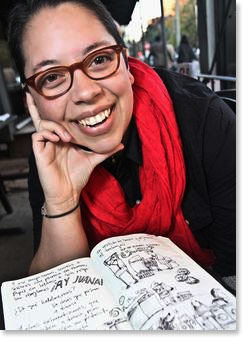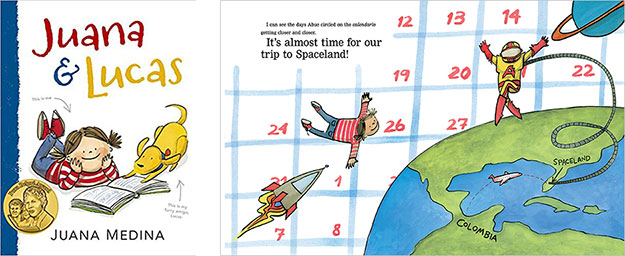Juana Medina was born in Bogotá, Colombia, where she has said that her drawings got her in trouble with her teachers. Happily for the children’s book world, Juana has turned her artistic skills to writing and illustrating. Juana received the prestigious 2017 Pura Belpre Award for Juana and Lucas (Candlewick), sure to be the first of many honors.
She studied at the Rhode Island School of Design (RISD) where she also taught. Juana currently teaches at George Washington University in Washington, D.C. and continues to write and illustrate books for young readers as well as for adult clients around the world.

Tell us about your childhood.
I grew up in Bogotá, Colombia, in the 80s. It was a hectic time in Colombia, because of a very long war. I had the fortune of growing up in a big city, within a family that valued books and encouraged me to be curious which somehow helped counter the effects of violence.
I grew up very close to my grandparents; my grandma was a fantastic woodworker and my grandfather a brain surgeon. They were both tinkerers and inventors — early on, they built equipment in my grandma’s studio for my grandfather to perform surgeries. They also built boats and wooden clocks and all sorts of things.
So I had the fortune of being around people whose excitement to create (and share their creations) was contagious. They were had a very meaningful influence on me. If I tell you about all my family members … this interview will turn into a book! In order to keep it short, I’ll tell you I had a memorable childhood, listening to many audiobooks while drawing and reading way past bedtime, simply because I couldn’t put books down. Thank goodness my mom pulled me out of reading every now and then to guarantee I’d get some fresh air and appreciate the beauty of this planet.
How much of the real Juana is reflected in Juana and Lucas ?
A fair amount! There are things like Spaceman and Spaceland, that are completely fictionalized (in reality, this was Disney World I was going to, eager to meet Mickey Mouse). And many cousins and uncles and aunts were cut out of the real story for clarity’s sake. Otherwise, Juana and Lucas would take at least eight tomes to unravel.
Was it the promise of a trip to an American theme park that inspired you to learn English as a child or was it something completely different?
My mom says one day she picked me up at school and I was furious. She asked what was wrong and I told her they wanted to teach me something called “the English” and that I didn’t want to learn it, whatever that was. She wisely said we were going to Disney World and that Mickey Mouse only spoke English. That solved it! I had to learn how to speak English. Of course, once we made it to Orlando, I found out that Mickey doesn’t even speak… I never imagined 30-something years later, I’d be writing this story, much less in English!

Juana and Lucas is presented as a traditional illustrated book but with elements of comics. How and why did you decide to combine these styles?
I wanted to make sure the book worked at a couple different levels:
The typography was meant to work not just as word, but also as form [in order] to add some playfulness and make the book more dynamic. Especially for those who might be reluctant readers, to have words pop out of the page and be drawn into figuring out more of the narrative. I also hope it injects some energy into the text, which we are so used to seeing formatted in a very quiet and structured way, that I thought it could use a bit of a shakeup.
I wanted illustrations to show Juana’s world and clue readers further into the Spanish that is peppered throughout the book. I also fear that many books for young readers drop the illustrations once children transition from picture books to chapter books, which I find absurd — there’s so much narrative to share through visuals!
In the end, the marriage of styles (visual and prose) seemed coherent and added up to something that I felt worked in order to tell this story.
You’ve written two concept books, 1 Big Salad: A Delicious Counting Book (Viking) and ABC Pasta: An Entertaining Alphabet (Viking). Both are about food and almost feel edible! How and why did you come up with this way of presenting counting and the alphabet to children?
These two books are part of a series I’ve been working on with Viking, for concept books (there’s a third one soon to come!).
I enjoy greatly looking at food as drawing material. Fruits and vegetables bring such vibrant colors to the page that they made my job very easy; I just had to come up with animals and draw a few lines!
The idea of pasta was a bit more complicated, I was looking for food/menu that would cover the whole alphabet. So with my dear editor and art director we brainstormed about picnics, pizza, sushi, soup (I don’t think I’d be adventurous enough to want to try a soup with ingredients from A through Z) … and arrived at pasta. A beloved type of food we can all learn a bit about.
In addition to writing and illustrating your own books, you’ve illustrated Smick! written by Doreen Cronin (Viking). How does Smick compare to other dogs in your life?
When I first read the manuscript for Smick!, it reminded me of a German Pointer I grew up with. This energetic dog called Max was curious and sweet and instantly became my muse for this book.
You’ve worked in animation, too, as well as other parts of graphic design and illustration. Talk a bit about you other work and how it may — or may not — relate to your books.
As time goes by, I realize there are a lot of overlaps between animation, design, and working on children’s books. Picture books feel very much like a thoughtful selection of frames from a movie, chosen to tell a story seamlessly.
Graphic design is so much about using visual elements to effectively get a message across, as well as bringing elements to a minimum and making a system work. All of this while still being playful, engaging, memorable, and efficient. All of these are concepts used while creating a children’s book.
How did you come to write and illustrate for young readers?
I’ve always enjoyed telling stories and drawing. It was a bit of a natural fit, though being terribly stubborn, it didn’t even cross my mind that I could do this! I was just obstinately trying to make a living doing other things (like becoming a physical therapist and later on, a designer working in advertisement). It took me a while to realize that this was something I could do and enjoy greatly.
You are bilingual and have lived in different countries and in different places in the U.S. What impact has this had or perhaps continue to have on your work as an author, artist, and teacher?
It has great impact! It allows you to perceive the world in a more complex way, to realize that it’s important to take time to listen and observe intently, to gather a better understanding of other’s realities. It also has helped me realize that being an outsider can be turned into an asset to think of it as being a bridge, to find empathy, to find humor, to share our humanity and realize we’re not that different after all.
What is your vision for the broad field of children’s literature?
I think there’s room for many more stories to be shared and I find that incredibly exciting. Visiting schools it is easy to realize how children are eager to read new content that includes each of them, so I hope we all can take that responsibility seriously and offer them comforting, thrilling and memorable stories they’ll hold on to for a lifetime.
What’s next for Juana Medina?
That’s a great question! I’m working on Juana and Lucas 2, wrapping up a sweet project with the Library of Congress and Poet Laureate Juan Felipe Herrera, and working a couple other projects.
I’m also, very slowly, figuring out what it means to be a new mother of twins, which so far, despite the sleep deprivation, has been the most exciting adventure I’ve lived.
Related resource
Watch the video interview with Poet Laureate Juan Felipe Herrera on our sister site, Colorín Colorado.

